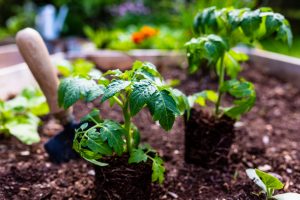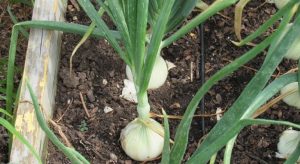Think tomatoes, peppers and onions: Time to plant them is now
By Nick Frillman University of Illinois Extension Educator — June 15, 2022
For tomatoes, water heavily at least twice per week. Tomatoes enjoy wet soils, not flooded soils. For peppers, thoroughly water, as needed, and at least once per week.
In late May and early June, folks worry it is too late to plant warm-season crops like tomatoes and peppers. Plant now, the timing is perfect for rapid root establishment and healthy plant growth.
With an average high of 76ºF and an average low of 55ºF, chilly nights (temperatures less than 50ºF) no longer threaten to stunt plant growth. If proper planting time is paired with regular watering, and proper training and pruning, plant vitality will be strong, and fruit set heavy.
Here is the scoop on watering peppers and tomatoes:
- To avoid stressing the plant, water at the base of the plant to limit wetness on leaves.
- Water early in the day to allow leaf moisture to dry before afternoon hours and dusk.
For tomatoes, water heavily at least twice per week. Tomatoes enjoy wet soils, not flooded soils. For peppers, thoroughly water, as needed, and at least once per week. For both crops, if it rains heavily, reduce watering.
Create a watering schedule, stay on it, then dial it in with daily observation. Check soil moisture throughout the season by probing the soil a few inches deep with your index finger. Repeat practice of this simple technique will help you learn when to water.
Prune pepper and tomato plants following plant establishment and indeterminate tomato plants throughout the growing season. For peppers, prune out the top pair of leaves, one to two weeks after planting to encourage strong root development and bushier growth which increases plant durability in strong winds. For all tomato plants (determinate and indeterminate), prune all foliage growth below the first fruiting truss (first “branch” with flowers) to prevent soil-borne disease and improve airflow.

If you are going to try growing onion eyes, a set is made up of individual slips that look like miniature leeks and are about the thickness of a pencil. They usually come in sets of 50.
For indeterminate tomatoes, continue to prune “suckers” (growth that originates at the main stem in the branch angle between the fruit truss and “leaf branch”) throughout the growing season to manage plant growth, improve aeration and increase fruit size. This practice will create a central leader growing system.
Resource guidance from your local garden center when shopping for determinate and indeterminate tomato plants.
Offer tomatoes and peppers support with a variety of store-bought or homemade trellises, cages or stakes. At planting, firmly insert your chosen support into the soil near the plant stem. Tie nylon twine or twist tie around support in a figure-eight pattern. Allow space between the cage and plant stem, do not tie too tightly together. Unsupported tomatoes, allowed to grow on the ground, are susceptible to soilborne diseases that rot fruit or kill the plant; unstaked peppers are liable to break in heavy storm winds.
Do you grow peppers and tomatoes every year? Are you ready to try something different (or maybe in addition to) the same-old, same-old? Then you should try growing onions this gardening season. With just 30 square feet of planting area, you could grow the bulk of the onions you cook with this year.
Onion availability
There is one small caveat to growing onions, availability. Since the pandemic began, growing staple foods in your own backyard is a hobby that has increased in popularity. In 2021, onion bunches — otherwise known as sets – sold out at local gardeners in two weeks.
If you are going to try growing eyes, visit the garden centers now.
A set is made up of individual slips that look like miniature leeks and are about the thickness of a pencil. They usually come in sets of 50. Get several bunches, they’re cheap. If you overbuy, you can give some away!
Preparation and Planting
- Prepare loosened garden soil
- Add some granular, slow-release, or pelletized garden fertilizer according to label instructions
- Add 1-2 inches of compost
Make small holes with your fingers in the prepared bed, then plant the slips 6 to 8 inches apart and 2 inches deep. Rows should also be about 6 to 8 inches apart. The roots and some of the bottom portion of the slip should be covered with soil. To gently secure the plant in the bed, cup both hands around the base of the slip and compact the compost just enough to hold the slip in place. Water them in.



